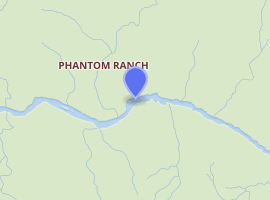Black Suspension Bridge
The Black Suspension Bridge (also known as the Kaibab Trail Suspension Bridge) spans the Colorado River in the inner canyon of Grand Canyon National Park. The span length is 440 feet.[1] The bridge is part of the South Kaibab Trail and is the river crossing used by mules going to Phantom Ranch. The Black Bridge and Silver Bridge, located about 700 meters downstream, are the only spans in hundreds of river miles.
Black Bridge | |
|---|---|
The Black Bridge from the South Kaibab Trail | |
| Coordinates | 36.1009°N 112.0892°W |
| Carries | Pedestrians, pack animals |
| Crosses | Colorado River |
| Locale | Grand Canyon National Park, Arizona, United States |
| Owner | National Park Service |
| Characteristics | |
| Design | Suspension bridge |
| Width | 5 feet |
| Longest span | 440 feet |
| History | |
| Designer | Ward P. Webber |

| |
History
Before 1907, the only way to cross the river was by boat, a dangerous method which cost many lives. Then, outdoorsman David Rust built a privately-operated cableway. The cableway was a six-foot by ten-foot steel cage large enough for one mule or several people would carry passengers across the river, but the passage was considered precarious. Theodore Roosevelt used the cableway in 1913.[2][3] The second crossing was a suspension bridge that lacked stiffness. It was built in 1920 and proved to be too flexible to safely carry pedestrians across the river as the number of visitors to the park was increasing.[4]
Black Bridge was designed by Ward Webber and constructed by John Lawrence.[2] The Black Bridge was built in 1928. It would remain the only crossing of the river for hundreds of river miles until the Silver Bridge was built just downstream within the park during the 1960s. As motorized vehicles could not access the construction site, humans and mules transported the 122 tons in materials down the nine miles of trail. Walking single file, 42 Havasupai tribesmen carried the one-ton, 550-foot suspension cables.[3]
Recognition
The bridge was documented in the Historical American Engineering Record in 1984.[2] On February 23, 2019, the bridge was recognized as a National Historic Engineering Landmark by the American Society of Civil Engineers, saying, "The Kaibab Trail Suspension Bridge is a prime example of engineering innovation. Engineering this bridge at the base of one of the world’s greatest wonders – the Grand Canyon – illustrates the resourcefulness and innovative spirit of the civil engineers responsible for this project." As of 2019, the bridge has remained unchanged since it was constructed 91 years ago.[1]
References
- "Vandell, Perry. 91-year-old Grand Canyon bridge named an engineering landmark". Arizona Republic, AZ Central. Retrieved February 25, 2019
- Witcher, T.R. (March 2019). Crossing Grand Canyon: The Kaibab Trail Suspension Bridge. Civil Engineering, pages 38-41, American Society of Civil Engineers.
- "Youngs, Yolonda. Black Bridge, archived from the original" on June 28, 2010. Nature, Culture and History at the Grand Canyon. Arizona State University. Retrieved May 5, 2019.
- Webber, Ward P. (February 1929) Report on the Design of the Kaibab Trail Bridge In Grand Canyon National Park, Arizona. Historic American Engineering Record, No. AZ-01.
External links
- Historic American Engineering Record (HAER) No. AZ-01, "Kaibab Trail Suspension Bridge", 26 photos, 0 color transparency, 4 measured drawings, 14 data pages, 2 photo caption pages
- Kaibab Trail Suspension Bridge (1920) at Structurae
- Kaibab Trail Suspension Bridge (1928) at Structurae